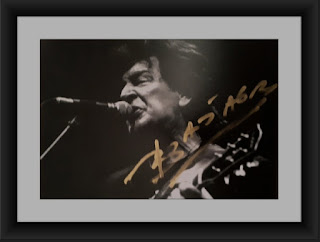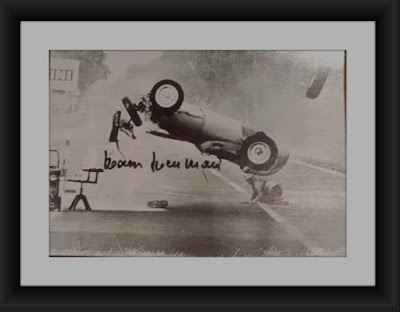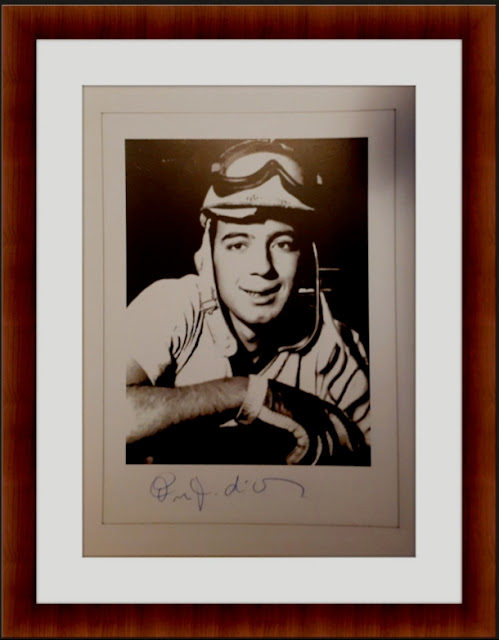 Momčilo Bajagić "Bajaga"
Momčilo Bajagić "Bajaga" (
Serbian Cyrillic:
Момчило Бајагић „Бајагa”) is a Serbian rock musician. He is best known as the leader of the Serbian and
former Yugoslav rock band
Bajaga i Instruktori, as well as a former member of the rock band
Riblja Čorba.
Early career
Bajagić
started his musical career as a singer for the band TNT. He wrote his
first song lyrics (for the song "Dvadeseta noć", trans. "Twentieth
Night") as a member of this band. After TNT disbanded in 1976, Bajagić
joined the band Ofi led by organist Toma "Ofinger" Stojković. After
Stojković left the band, Bajagić and two other Ofi members, drummer
Dragan "Đera" Đerić and vocalist Živorad "Žika" Milenković, formed the
band Glogov Kolac (Hawthorn Stake) with guitarist Rajko Kojić. After only one performance Glogov Kolac, disbanded. Bajagić refused Boban Petrović's invitation to join Zdravo, while Kojić joined the band SOS and later Riblja Čorba.
Riblja Čorba
In 1978, on suggestion of Bajagić's former bandmate Rajko Kojić, Bajagić was invited to join
Riblja Čorba
as rhythm guitarist. Bajagić recorded six albums with the band. He
wrote songs "Ja sam se ložio na tebe" ("I Was Crushing on You"), "Baby,
Baby I Don't Wanna Cry", "Muzičari koji piju" ("Musicians Who Drink")
and "
Kad hodaš" ("When You Walk"). He co-wrote the songs "Dva dinara, druže" ("Two
Dinars,
Comrade"), "Nemoj srećo, nemoj danas" ("Don't Honey, Don't Do It
Today"), "Kazablanka" ("Casablanca"), "Evo ti za taksi" ("Here's Some
for the Cab"), "Draga, ne budi peder" ("Honey, Don't Be a Faggot"),
"Dobro jutro" ("Good Morning"), "Odlazak u grad" ("Leaving to the
City"), "Srećan put, pišo moja mala" ("Have A Nice Trip, My Little
Winky"), and others.

During his work with Riblja Čorba, Bajagić wrote a number of humorous
pop rock songs that did not fit into the band's
hard rock sound and decided to release a solo album. He recorded the album
Pozitivna geografija (
Positive Geography) with musicians who would later become members of his band
Bajaga i Instruktori: vocalist
Dejan Cukić (a former Dizel, Tilt and
Bulevar member), bass guitarist Miroslav "Cvele" Cvetković (a former Tilt,
Pop Mašina and Papatra member), guitarist Nenad Stamtović (a former Tilt, Zebra,
Suncokret
and Bulevar member) and drummer Vladimir Golubović (a former Tilt,
Suncokret and Riblja Čorba member). The album was produced by
Kornelije Kovač
and was released at the end of January 1984, bringing hits "Limene
trube" ("Brass Trumpets"), "Tekila gerila" ("Tequila Guerilla"), "Mali
slonovi" ("Little Elephants"), "Marlena", and "Pustite me, druže" ("Let
Me Go, Comrade"). Although released as Bajagić's solo album,
Pozitivna geografija
was later included in Bajaga i Instruktori official discography, as it
featured future Bajaga i Instruktori members. Bajagić and the musicians
that were involved in the album recording performed in
Kulušić club in
Zagreb on 12 April 1984, and on 21 April in
Dom Sindikata in
Belgrade, appearing as Bajaga i Instruktori (
Bajaga and the Instructors) for the first time on the latter concert.
At the time of the album recording, Bajagić wanted to remain a
member of Riblja Čorba, but the popularity of his songs caused conflicts
inside the band. In July 1984 he was, alongside Kojić, excluded from
Riblja Čorba, and started a tour with his new band.
Bajaga i Instruktori
Led by Bajagić, Bajaga i Instruktori became one of the most successful and influential rock bands of the
former Yugoslav and
Serbian rock scene.
Their string of albums in the mid-to-late 1980s placed them at the very
top of the former Yugoslav rock scene, alongside other mega-selling
bands such as
Bijelo Dugme and Riblja Čorba. The band has released nine studio albums (including
Pozitivna geografija).
Solo works
Bajagić has released two solo albums, both featuring soundtracks written by Bajagić:
Ni na nebu ni na zemlji (for the film of the same name)
[1] and
Profesionalac – Muzika iz filma (for the film
The Professional). Bajagić recorded the latter with
pop rock/
folk rock band
Apsolutno Romantično.
[2] He also composed the music for TV series
Otvorena Vrata.
[3]
Album production
Bajagić produced
Bezobrazno Zeleno debut album
BZ1 released in 1983.
[4] He produced Heroji only album,
88 (1988),
[5] as well as their 7" single "Bilder" / "Instruktor skijanja" ("Bodybuilder" / "Skiing Instructor", released in 1986).
[6] He produced his solo album
Profesionalac – Muzika iz filma,
[7] and participated in the production of Bajaga i Instruktori releases
Četiri godišnja doba (
Four Seasons, released in 1991)
[8] and
Muzika na struju (
Electric Music, released in 1993).
 Sicilians were trusting the skill of Vaccarella's driving.[4] Vaccarella qualified eighth for the 1970 24 Hours of Daytona in a Ferrari 512S. He also drove the big V12-powered Ferrari 512S in a heroic yet ultimately losing effort in 1970, damaging the car in the final stages.
This was one of a series of 11 endurance events held in Europe and North America for the 1970 world manufacturers championship.[6] Vaccarella and Toine Hezemans won the 1971 Targa Florio in an Alfa Romeo. They crossed the finish line over a minute ahead of Andrea de Adamich and Gijs van Lennep,
who also drove an Alfa Romeo. This race ended the dominance of Porsche,
which had finished first in the previous five Targa Florio races.[7]
Vaccarella competed in the 1972 12 Hours of Sebring in one of four Alfa
Romeo 33/3TT's to be entered in the event. His driving partner was Nanni Galli.[8] They qualified fifth after another Alfa Romeo of Rolf Stommelen and Peter Revson, who started third.[9]
Sicilians were trusting the skill of Vaccarella's driving.[4] Vaccarella qualified eighth for the 1970 24 Hours of Daytona in a Ferrari 512S. He also drove the big V12-powered Ferrari 512S in a heroic yet ultimately losing effort in 1970, damaging the car in the final stages.
This was one of a series of 11 endurance events held in Europe and North America for the 1970 world manufacturers championship.[6] Vaccarella and Toine Hezemans won the 1971 Targa Florio in an Alfa Romeo. They crossed the finish line over a minute ahead of Andrea de Adamich and Gijs van Lennep,
who also drove an Alfa Romeo. This race ended the dominance of Porsche,
which had finished first in the previous five Targa Florio races.[7]
Vaccarella competed in the 1972 12 Hours of Sebring in one of four Alfa
Romeo 33/3TT's to be entered in the event. His driving partner was Nanni Galli.[8] They qualified fifth after another Alfa Romeo of Rolf Stommelen and Peter Revson, who started third.[9]





























